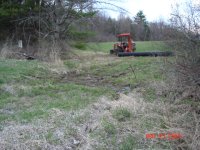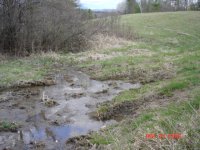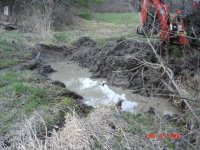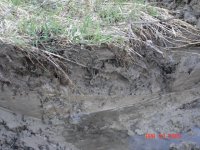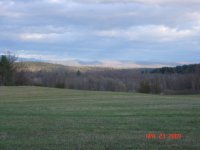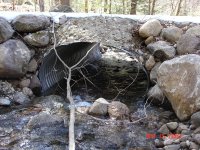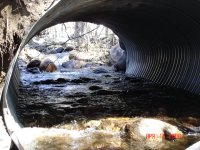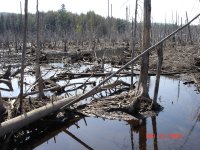deputyrpa
Gold Member
I'm at it again.  This is the last field culvert I have to install for safe farming. The crossing site is just below a spring area, and we have been just driving thru the mucky clay to access the field for years. Last fall we almost tipped a loaded hay wagon over, and this winter I almost tipped my DK over while trying to get unstuck. My neighbor had to drag me out while I maintained bucket downpressure. It's time.
This is the last field culvert I have to install for safe farming. The crossing site is just below a spring area, and we have been just driving thru the mucky clay to access the field for years. Last fall we almost tipped a loaded hay wagon over, and this winter I almost tipped my DK over while trying to get unstuck. My neighbor had to drag me out while I maintained bucket downpressure. It's time.
Here are some pics. As one can see, its's a mess. Since the discharge area is immediately upstream and there are ruts from driving thru it, there is no channel form until about 100 feet downstream, from the crossing. From thereon downstream, it's a typical incised clay channel. I'll deal with that later with cross vanes and such. The are is soup, with solid clay at least a foot or more down. I had to excavate all that soupy stuff out to prepare a solid base for the culvert to sit upon. That "schlop" kept running back into the excavation area. After I excavated tonight, I have to wait a few days to dewater the excavated clay. One pic shows the water pouring out, and the thick clay below the loam. It's looks ugly now, but it will only get better from here.
I have to place almost a foot of dry clay below the culvert to make sure I have the invert elevation high enough. Gravel over the clay will allow piping leading to failure. The problem is that I can't do it while water is present. So I have a choice - excavate a temporary bypass channel, or place the culvert in the current channel, get the water running thru it, and backfill little by little from the outlet to the inlet while lifting the culvert up each time. I did the latter sucessfully with my first culvert install. The problem with a bypass channel is that once the first foot of loamy ground is saturated, the bypass channel are will turn to mush and will take a very long time to dry.
More to come Saturday!
Here are some pics. As one can see, its's a mess. Since the discharge area is immediately upstream and there are ruts from driving thru it, there is no channel form until about 100 feet downstream, from the crossing. From thereon downstream, it's a typical incised clay channel. I'll deal with that later with cross vanes and such. The are is soup, with solid clay at least a foot or more down. I had to excavate all that soupy stuff out to prepare a solid base for the culvert to sit upon. That "schlop" kept running back into the excavation area. After I excavated tonight, I have to wait a few days to dewater the excavated clay. One pic shows the water pouring out, and the thick clay below the loam. It's looks ugly now, but it will only get better from here.
I have to place almost a foot of dry clay below the culvert to make sure I have the invert elevation high enough. Gravel over the clay will allow piping leading to failure. The problem is that I can't do it while water is present. So I have a choice - excavate a temporary bypass channel, or place the culvert in the current channel, get the water running thru it, and backfill little by little from the outlet to the inlet while lifting the culvert up each time. I did the latter sucessfully with my first culvert install. The problem with a bypass channel is that once the first foot of loamy ground is saturated, the bypass channel are will turn to mush and will take a very long time to dry.
More to come Saturday!
Attachments
Last edited:
